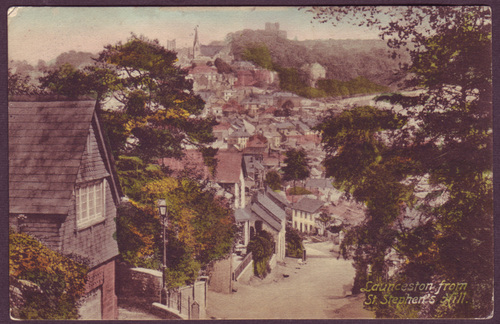After consolidating their control over England the Normans cautiously extended their rule westwards, reaching the Tamar by 1070. A few decades later, they were busy building a border castle to awe the natives at what is now Launceston. Except that it wasn’t Launceston before the 1150s. The name Lansteffan, meaning the holy site of Stephen, was before that date reserved for St Stephens, across the steep valley. St Stephens had boasted a monastery and a market when what became Launceston was still a largely uninhabited down. Having lost its name, St Stephens stagnated as Launceston grew and by the Victorian period was a typical rural parish dominated by its farms.

Its mid-century children, or at least those in our database, were not keen to travel far. Ten of the 13 were still found in Cornwall in 1891, all but one in the Launceston district. Two were dead and just one had made it across the nearby border and into England. The exception was Richard Treleaven. Richard had been born in St Stephens and in 1861, together with four other boys, was boarding at a small school in Newport, the settlement down the hill from St Stephen’s church. Richard’s education fitted him for a clerical career and he headed for London.
In 1871 he was found living in a large dormitory with 50 drapers’ assistants and apprentices in Holborn, although he was himself a ‘commercial clerk, drapery’. These dormitories, found in all the big cities of Britain by the mid-1800s, were provided in lieu of part of the assistants’ wages and were a sign of the more impersonal nature of drapery shopwork. Soon, the small shops of the mid-1800s would begin to be replaced by larger ones selling ready-made rather than made-to-order clothing,
Richard stayed in London. In 1877 he got married and in 1881 was working as a draper’s assistant but in his own home in St Pancras, even employing a family servant. By 1891 his description was ‘fancy draper’, having moved to a house in Brixton Road, Lambeth (and still with a servant). However, later in the 1890s he made an abrupt career change, switching from drapery to catering. He and his wife Julia moved to run a restaurant in Holborn, close to the City, their sons helping with the cooking. Restaurants were a new departure in the years after the 1850s, providing more elaborate dining and a wider variety of food than the formerly ubiquitous eating houses or dining rooms. Restaurants also welcomed women. Before their arrival, it was not done for women to dine in public. By the 1880s moreover, restaurants were being joined by tea shops, where even a lone woman could dine respectably.
By 1911 Richard and Julia had moved again out to a comfortable house in the suburbs of east London at Leyton, which grew substantially after the 1870s. He was still recorded as a caterer and an employer and his son Arthur was a chef and confectioner. The pair may well have been commuting to their restaurant by this time on the railway that had enabled Leyton’s population to soar.

Thanks, Bernard. I enjoy your blogs.
This reminded me of my late father, Bert Tremain. He left school at 14 and worked in L anson for a while before moving to London where he worked for Cook,Son & Co. Of St. Paul’s Churchyard. They had a large warehouse across the river at Blackfriars, and the apprentices lived in a large dormitory on the top floor. He had happy memories of his time there before the War.
Sounded Dickensian to me.
Regards,
Rob.
LikeLike
It was Dickensian! I’d assumed the practuce died out after the First World War. But when was your father there? Sounds as if it survived later.
LikeLike
Dad was born in 1917 at Delabole. He left school at 14. Travelling by train to Lanson, he started work at Lyndon Cooks in Southgate Street. At the age of 17 he moved to London. He joined the Ealing Manor Road Club and competed in many cycling races. In 1938 Dad and his pal Monty Cox were within seconds of being world tandem champions. Many of his pals from those days were lifelong friends. The Ravensbourne Club was Cooks sports club and Dad and his pals made good use of the sports facilities. All came to an end in 1939.
LikeLike